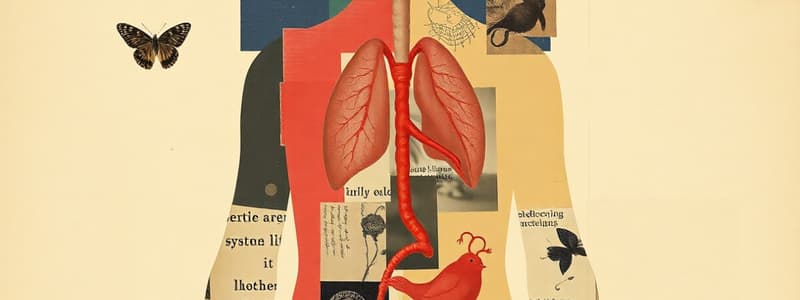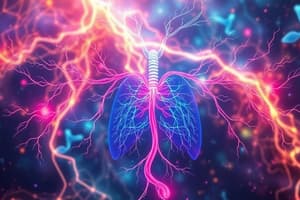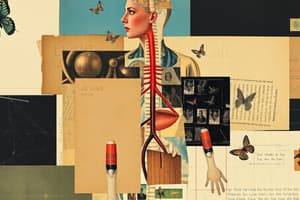Podcast
Questions and Answers
What is the final product of the translation process?
What is the final product of the translation process?
- Nucleotides
- Protein/polypeptide (correct)
- RNA
- DNA
Which statement accurately describes the action of lipid-soluble hormones?
Which statement accurately describes the action of lipid-soluble hormones?
- They cannot pass through the plasma membrane.
- They exclusively affect genes unrelated to protein synthesis.
- They enter the cell and bind to receptors inside. (correct)
- They bind to receptors on the cell surface.
What role does the hormone-receptor complex play in the nucleus?
What role does the hormone-receptor complex play in the nucleus?
- It destroys the existing RNA.
- It binds to proteins for storage.
- It exits the nucleus to find more hormones.
- It activates specific genes to produce mRNA. (correct)
In which part of the cell does the steroid hormone bind to its receptor?
In which part of the cell does the steroid hormone bind to its receptor?
What happens to mRNA after it is produced in the nucleus?
What happens to mRNA after it is produced in the nucleus?
What is the first step in the process of lipid-soluble hormones acting on target cells?
What is the first step in the process of lipid-soluble hormones acting on target cells?
Which of the following best describes the sequence of events after the steroid hormone binds to its receptor?
Which of the following best describes the sequence of events after the steroid hormone binds to its receptor?
What is the ultimate effect of enzymes synthesized in response to the hormone action?
What is the ultimate effect of enzymes synthesized in response to the hormone action?
Which hormone controls the adrenal cortex?
Which hormone controls the adrenal cortex?
What is the primary function of mineralocorticoids such as aldosterone?
What is the primary function of mineralocorticoids such as aldosterone?
Which part of the adrenal glands is directly controlled by the hypothalamus through nerve signals?
Which part of the adrenal glands is directly controlled by the hypothalamus through nerve signals?
Which of the following is NOT a hormone secreted by the adrenal cortex?
Which of the following is NOT a hormone secreted by the adrenal cortex?
What is the effect of epinephrine when secreted by the adrenal medulla?
What is the effect of epinephrine when secreted by the adrenal medulla?
Which structure is responsible for the secretion of ACTH?
Which structure is responsible for the secretion of ACTH?
What is the main role of glucocorticoids like cortisol?
What is the main role of glucocorticoids like cortisol?
Which of the following effects is associated with the secretion of epinephrine?
Which of the following effects is associated with the secretion of epinephrine?
Which part of the pituitary gland releases hormones it produces upon receiving signals from the hypothalamus?
Which part of the pituitary gland releases hormones it produces upon receiving signals from the hypothalamus?
What is the primary function of Thyroid-stimulating hormone (TSH)?
What is the primary function of Thyroid-stimulating hormone (TSH)?
What role does Adrenocorticotropic hormone (ACTH) play in the body?
What role does Adrenocorticotropic hormone (ACTH) play in the body?
What role does testosterone play during development?
What role does testosterone play during development?
Which hormone is primarily secreted by the pineal gland?
Which hormone is primarily secreted by the pineal gland?
Which hormones are classified as gonadotropic hormones?
Which hormones are classified as gonadotropic hormones?
What is the target of Prolactin (PRL)?
What is the target of Prolactin (PRL)?
What is one of the functions of estrogen in females?
What is one of the functions of estrogen in females?
What is the primary function of the antidiuretic hormone (ADH)?
What is the primary function of the antidiuretic hormone (ADH)?
What effect does renin have in the body?
What effect does renin have in the body?
What is the function of Growth hormone (GH)?
What is the function of Growth hormone (GH)?
Which hormone is responsible for stimulating water reabsorption by the kidneys?
Which hormone is responsible for stimulating water reabsorption by the kidneys?
Which gland stores and releases the hormones produced by the hypothalamus?
Which gland stores and releases the hormones produced by the hypothalamus?
During male development, testosterone is responsible for which of the following?
During male development, testosterone is responsible for which of the following?
Which hormone is NOT produced by the hypothalamus?
Which hormone is NOT produced by the hypothalamus?
What is one of the roles of melatonin in the body?
What is one of the roles of melatonin in the body?
What is the target of Luteinizing Hormone (LH) in males?
What is the target of Luteinizing Hormone (LH) in males?
Which hormone is involved in stimulating the bone marrow to produce more red blood cells?
Which hormone is involved in stimulating the bone marrow to produce more red blood cells?
What is one of the primary effects of antidiuretic hormone (ADH) on blood pressure?
What is one of the primary effects of antidiuretic hormone (ADH) on blood pressure?
Which hormone is primarily responsible for regulating ovarian and uterine cycles in females?
Which hormone is primarily responsible for regulating ovarian and uterine cycles in females?
Which function is NOT associated with the hypothalamus?
Which function is NOT associated with the hypothalamus?
Which part of the body does the antidiuretic hormone (ADH) primarily target?
Which part of the body does the antidiuretic hormone (ADH) primarily target?
Antidiuretic hormone (ADH) causes the kidneys to perform which of the following actions?
Antidiuretic hormone (ADH) causes the kidneys to perform which of the following actions?
Which hormone helps control water balance in the body?
Which hormone helps control water balance in the body?
What is the primary function of oxytocin?
What is the primary function of oxytocin?
Which hormone is synthetically produced to induce labor?
Which hormone is synthetically produced to induce labor?
What type of hormones does the hypothalamus produce that affect the anterior pituitary gland?
What type of hormones does the hypothalamus produce that affect the anterior pituitary gland?
Which of the following hormones is NOT produced by the anterior pituitary gland?
Which of the following hormones is NOT produced by the anterior pituitary gland?
What role do the hypothalamic hormones play in relation to the anterior pituitary gland?
What role do the hypothalamic hormones play in relation to the anterior pituitary gland?
Which of the following hormones is responsible for stimulating milk release from mammary glands?
Which of the following hormones is responsible for stimulating milk release from mammary glands?
What is the primary target of prolactin (PRL)?
What is the primary target of prolactin (PRL)?
Which nerves produce antidiuretic hormone (ADH)?
Which nerves produce antidiuretic hormone (ADH)?
Flashcards
Transcription Product
Transcription Product
mRNA (messenger RNA)
Translation Product
Translation Product
Protein/polypeptide
Lipid-soluble Hormone
Lipid-soluble Hormone
Hormone that can pass through the cell membrane without a carrier.
Lipid-soluble Hormone Receptor
Lipid-soluble Hormone Receptor
Signup and view all the flashcards
Hormone-Receptor Complex
Hormone-Receptor Complex
Signup and view all the flashcards
Nuclear Action
Nuclear Action
Signup and view all the flashcards
mRNA Synthesis
mRNA Synthesis
Signup and view all the flashcards
Protein Synthesis
Protein Synthesis
Signup and view all the flashcards
Hypothalamus function
Hypothalamus function
Signup and view all the flashcards
Hypothalamic hormones
Hypothalamic hormones
Signup and view all the flashcards
Antidiuretic Hormone (ADH)
Antidiuretic Hormone (ADH)
Signup and view all the flashcards
ADH target
ADH target
Signup and view all the flashcards
Diuretic effect on urine
Diuretic effect on urine
Signup and view all the flashcards
Antidiuretic effect on urine
Antidiuretic effect on urine
Signup and view all the flashcards
ADH effect on blood pressure
ADH effect on blood pressure
Signup and view all the flashcards
Oxytocin function
Oxytocin function
Signup and view all the flashcards
Oxytocin function
Oxytocin function
Signup and view all the flashcards
Pitocin
Pitocin
Signup and view all the flashcards
Hypothalamus control
Hypothalamus control
Signup and view all the flashcards
Anterior Pituitary Hormones
Anterior Pituitary Hormones
Signup and view all the flashcards
Hypothalamic-Releasing Hormones
Hypothalamic-Releasing Hormones
Signup and view all the flashcards
Hypothalamic-Inhibiting Hormones
Hypothalamic-Inhibiting Hormones
Signup and view all the flashcards
Anterior Pituitary
Anterior Pituitary
Signup and view all the flashcards
Prolactin (PRL)
Prolactin (PRL)
Signup and view all the flashcards
Posterior Pituitary Function
Posterior Pituitary Function
Signup and view all the flashcards
Anterior Pituitary Function
Anterior Pituitary Function
Signup and view all the flashcards
TSH Function
TSH Function
Signup and view all the flashcards
ACTH Function
ACTH Function
Signup and view all the flashcards
Gonadotropic Hormones
Gonadotropic Hormones
Signup and view all the flashcards
FSH Function
FSH Function
Signup and view all the flashcards
LH Function
LH Function
Signup and view all the flashcards
ADH Hormone Function
ADH Hormone Function
Signup and view all the flashcards
ACTH production location
ACTH production location
Signup and view all the flashcards
Adrenal gland parts
Adrenal gland parts
Signup and view all the flashcards
Adrenal medulla control
Adrenal medulla control
Signup and view all the flashcards
Adrenal cortex control
Adrenal cortex control
Signup and view all the flashcards
Mineralocorticoids example
Mineralocorticoids example
Signup and view all the flashcards
Mineralocorticoid action
Mineralocorticoid action
Signup and view all the flashcards
Glucocorticoid example
Glucocorticoid example
Signup and view all the flashcards
Epinephrine function
Epinephrine function
Signup and view all the flashcards
Testosterone Effects
Testosterone Effects
Signup and view all the flashcards
Estrogen and Progesterone Effects
Estrogen and Progesterone Effects
Signup and view all the flashcards
Pineal Gland Hormone
Pineal Gland Hormone
Signup and view all the flashcards
Erythropoietin Function
Erythropoietin Function
Signup and view all the flashcards
Renin's Role
Renin's Role
Signup and view all the flashcards
ADH Target
ADH Target
Signup and view all the flashcards
Oxytocin Function
Oxytocin Function
Signup and view all the flashcards
Kidneys' Hormone Release
Kidneys' Hormone Release
Signup and view all the flashcards
Study Notes
The Endocrine System
- The endocrine system works with the nervous system to regulate and control other systems, maintaining homeostasis.
- The endocrine system functions by releasing hormones that travel through the bloodstream to target cells.
- Glands are secretory cells or structures derived from muscle, connective tissue, epithelial or nervous tissue.
- Hormones are chemical messengers secreted by one cell that travel to another cell, affecting only target cells with the correct receptor.
- Target cells have receptors that bind hormones; non-target cells lack these receptors and aren't affected.
- Hormones and Neurotransmitters work together for homeostasis. They are both controlled by negative feedback but differ in location and speed of action.
- Hormones are slower-acting and remain in the body longer than neurotransmitters.
Types of Hormones
- There are two types of hormones: water-soluble (hydrophilic) and lipid-soluble (hydrophobic).
- Water-soluble hormones (amino acids and polypeptides like epinephrine) bind to receptors on the cell surface, triggering the formation of a secondary messenger (ex: cAMP), activating cellular activity.
- Lipid-soluble hormones (steroids like estrogen and testosterone) pass through the plasma membrane, bind with a receptor inside the cell, bind to DNA and activate transcription to initiate protein production.
Specific Hormones and Their Functions
- Hypothalamus: Regulates internal environment by influencing the autonomic nervous system, controlling heartbeat, body temperature, and water balance. It also produces ADH and oxytocin; important hormones that control the pituitary gland.
- ADH (Antidiuretic Hormone): Regulates water reabsorption in the kidneys, returning water to the bloodstream.
- Oxytocin: Stimulates uterine contractions during childbirth and milk release (ejection).
- Pituitary Gland (Anterior): Produces thyroid-stimulating hormone (TSH), adrenocorticotropic hormone (ACTH), gonadotropic hormones (FSH and LH), prolactin (PRL), and growth hormone (GH).
- TSH (Thyroid-stimulating Hormone): Stimulates the thyroid gland to produce thyroxine.
- ACTH (Adrenocorticotropic Hormone): Stimulates the adrenal cortex to produce cortisol.
- FSH (Follicle-stimulating Hormone)/LH (Luteinizing Hormone): Stimulate the gonads (testes and ovaries) to produce gametes and hormones. - FSH stimulates gamete development in both genders. - LH stimulates the ovaries to make estrogen and progesterone and testes to produce testosterone.
- PRL (Prolactin): Stimulates mammary glands to develop and produce milk.
- GH (Growth Hormone): Promotes skeletal and muscular growth.
- Pituitary Gland (Posterior): Receives ADH and oxytocin from the hypothalamus, stores them, and releases them.
- Thyroid Gland: Requires iodine to produce hormones.
- Thyroxine: Regulates metabolism by stimulating protein synthesis, lipid breakdown, and glucose use for ATP production.
- Calcitonin: Lowers blood calcium levels by depositing calcium into bone and signaling the kidneys to release more calcium into the urine.
- Parathyroid Gland: Produces parathyroid hormone (PTH), which increases blood calcium levels by removing calcium from the bone, increasing calcium absorption from the intestines, and decreasing calcium excretion from the kidneys.
- Adrenal Glands: Composed of the adrenal medulla and cortex.
- Adrenal Medulla: Secretes epinephrine. Prepares the body for quick action (“fight-or-flight” response), increasing blood pressure, heart rate, and blood glucose levels.
- Adrenal Cortex: Secretes mineralocorticoids (like aldosterone) and glucocorticoids (like cortisol).
- Aldosterone: Promotes water reabsorption by the kidneys, increasing blood pressure.
- Cortisol: Affects glucose homeostasis, promoting fat and protein conversion to intermediate substances usable by body cells. Inhibits inflammatory response
- Pancreas: Regulates blood glucose levels via glucagon and insulin.
- Glucagon: Raises blood glucose levels by stimulating the liver to break down glycogen to glucose and to create glucose from lactic acid.
- Insulin: Lowers blood glucose levels by stimulating the transport of glucose into muscle, white blood cells, and connective tissues; inhibiting glycogen breakdown in the liver; preventing the conversion of amino and fatty acids into glucose; and stimulating triglyceride formation from glucose in adipose tissue.
- Kidneys: Release erythropoietin, which stimulates the bone marrow to produce more red blood cells. They also produce renin to stimulate the adrenal cortex to release aldosterone.
- Gonads: Ovaries (female) produce estrogen and progesterone which regulates reproductive organs secondary sex characteristics, egg maturation, etc. Testes (male) produce testosterone that promotes growth and traits related to male development.
- Pineal Gland: Located in the brain, secretes melatonin, involved in daily sleep-wake cycles and sexual development.
Important Concepts
- The endocrine system and the nervous system work together for homeostasis.
- Hormones are classified as water-soluble or lipid-soluble, affecting target cells differently.
- Understanding how the hypothalamus controls the pituitary gland, and the different parts and functions of the adrenal glands are crucial.
- The regulation of calcium and glucose levels in the blood is essential for maintaining homeostasis, regulated by different hormones.
Studying That Suits You
Use AI to generate personalized quizzes and flashcards to suit your learning preferences.




